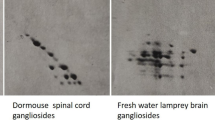Summary
Brain from mature rats has been shown previously to contain a natural inhibitor of rat brain sialyltransferase I (CMP-sialic acid: lactosylceramide sialyltransferase activity). This same inhibitor preparation was effective against sialyltransferase I and a second sialyltransferase activity from different lines of cultured cells. Cardiolipin which stimulates sialyltransferase I activity in cultured cells apparently was not required for inhibition. Inhibition was specific for sialyltransferase activities while a third ganglioside biosynthetic enzyme, UDP-gal: glucosyl-ceramide galactosyltransferase activity, was not inhibited. Inhibition of sialyltransferase I was linear with time, heat-resistant, and increased with inhibitor concentration.
Gangliosides are sialic-acid containing glycosphingolipids found in brain as well as extraneural tissues and cultured cells t,2. Although the functions of gangliosides are unknown, they appear to play a role in morphological differentiation3 sensory and visual stimulation 4 and as receptor for cholera toxin5–8 and possibly thyroid stimulating hormone9. The monosaccharide units are added to the elongating oligosaccharide chain of the gangliosides in step-wise fashion and different glycosyltransferases catalyze each addition10,11. The activities of these enzymes have been observed to change during development12,14 malignant transformation13 and morphological differentiation3.
Although little is known about the regulation of ganglioside synthesis, a natural inhibitor of CMP-AcNeu: GL-2 sialyltransferase (sialyltransferase I) from rat brain has been described14,15. As the inhibitor activity increased with the age of the animal, the same authors suggested that it may regulate the biosynthetic pathway of gangliosides. In this paper, the effects of the rat brain inhibitor on the activities of ganglioside biosynthetic enzymes from several cultured cell lines are described.
Similar content being viewed by others
Abbreviations
- AcNeu:
-
N-acetylneuraminic acid
- GL1:
-
glucosylceramide
- GL-2:
-
lactosylceramide
- GM3 :
-
Nacetylneuraminylgalactosylglucosylceramide
- GM1 :
-
gal actosyl-N-acetylgalactosaminyl-(N-acetylneuraminylgalactosylglucosylceramide
- GD1a :
-
Nacetylneuraminylgalactosyl-N-acetylgalactosaminyl-(Nacetylneuraminyl)-galactosylglucosylceramide.
References
Wiegandt, H., 1968. Angew. Chem. 80, 89–98.
Svennerholm,L., 1964. J. Lipid Res. 5, 145–155.
Fishman, P. H., Bradley, R. M. and Henneberry, R. C., 1976. Arch. Biochem. Biophys. 172, 618–626.
Macioni, A. H. R., Giménez, M. S., Caputto, B. L. and Caputto, R., 1974. Brain Research. 73, 503–511.
Cuatrecases, P., 1973. Biochemistry 12, 3558–3566.
Holmgren, J., Lonroth, L. and Svennerholm, L., 1973. Infect. Immun. 8, 208–214.
Van Heyningen, W. E. 1974. Nature 249, 415–417.
Moss, J., Fishman, P. H., Manganiello, V. C., Vaughan, M. and Brady, R. O., 1976. Proc. Nat. Acad. Sci., USA 73, 1034–1037.
Mullin, B. R., Fishman, P. H., Lee, G., Aloj, S. M., Ledley, F. D., Winand, R. J., Kohn, L. D. and Brady, R. O., 1976. Proc. Nat. Acad. Sci, USA 73, 842–846.
Author information
Authors and Affiliations
Additional information
DR. DUFFARD was a recipient of a Fogarty Center Fellowship.
Rights and permissions
About this article
Cite this article
Duffard, R.O. Inhibition of sialyltransferase activity in cultured cells by a natural inhibitor from rat brain. Mol Cell Biochem 26, 119–122 (1979). https://doi.org/10.1007/BF00232889
Received:
Issue Date:
DOI: https://doi.org/10.1007/BF00232889




